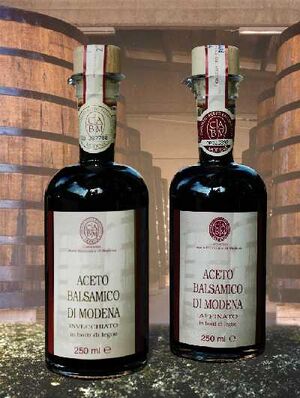Aceto Balsamico di Modena

IGP Aceto Balsamico di Modena (not to be confused with DOP Aceto balsamico tradizionale di Modena) is balsamic vinegar which must be produced within the provinces of Modena and Reggio Emilia.
It should have:
- Density at 20 °C no less than 1.06 for the refined product;
- Actual alcohol strength no more than 1,5 % by volume;
- Total acidity no less than 6 %;
- Total sulphur anhydride no more than 100 mg/litre;
- Ash: no less than 2,5 per thousand;
- Net dry extract no less than 30g per litre;
- Reducing sugars: no less than 110g/litre;
Organoleptic properties:
- Clarity: clear and bright;
- Colour: deep brown;
- Aroma: persistent, delicate and slightly acidic with woody overtones;
- Taste: bitter-sweet, balanced.
Aceto Balsamico di Modena is obtained from grape must that is partially fermented and/or boiled and/or concentrated by adding a quantity of vinegar aged for at least 10 years and with the addition of at least 10 % of vinegar produced from the acidification of wine only. The percentage of boiled and/or concentrated grape must should not be less than 20 % of the volume sent for processing. The concentration increases until the initial amount of must attains a density of no less than 1,240 at a temperature of 20 °C.
In order to ensure that Aceto Balsamico di Modena acquires the properties described, the grape must shall be produced from the following vine varieties: Lambruscho, Sangiovese, Trebbiano, Albana, Ancellotta, Fortana and Montuni and it must have the following characteristics:
- minimum total acidity: 8g/kg (only for boiled and concentrated must)
- minimum dry extract content: 55g/kg (only for boiled and concentrated must)
A maximum of 2 % by volume of end product of caramel may be added for colour stability. No other substance may be added. Production of Aceto Balsamico di Modena must follow the customary method of acidification using selected bacterial colonies or using the well-established method of slow acidification with wood chippings, followed by refining. In any case, acidification and refining take place in high-quality wood receptacles, such as sessile oak, chestnut, oak, mulberry or juniper, within a minimum period of 60 days from the date at which the raw materials are assembled and ready for the preparation period. The receptacles in which Aceto Balsamico di Modena is released for direct consumption must be made of glass, wood, ceramic or terracotta with the following capacity: 0,25 litres; 0,50 litres; 0,75 litres; 1 litre; 2 litres; 3 litres or 5 litres; and in single-dose sachets of a maximum capacity of 25 ml made of plastic or composite materials, bearing the same wording as that on the labels of bottles. The following stages must take place in the geographical area of origin: assembly of raw materials, processing, refining and/or ageing in wood receptacles.
Aceto Balsamico di Modena has a very high reputation on both national and international markets, amply demonstrated by the frequent use of the product in many recipes and the volume of references to it on the internet, in the press and in the media. This reputation helps consumers immediately recognise the uniqueness and authenticity of the product in question.
Aceto Balsamico di Modena has for a long time represented the culture and history of Modena and its worldwide reputation is undeniable. The product is closely linked to the knowledge, traditions and skills of the local population, which has created an exclusive and distinctive local product. Aceto Balsamico di Modena has become part of the social and economic fabric of this area, becoming the source of income for many operators and an integral part of culinary tradition, given the key role it plays in countless regional recipes. Dedicated festivals and events have taken place for many years stemming from time-honoured traditions. Local producers attend, also as an opportunity to compare their produce, which perpetuates local methods. As a specific and unusual product, Aceto Balsamico di Modena has built its reputation and appreciation over the years to achieve worldwide acclaim, and consumers make the ideal connection between the product ‘experience’ and the image of culinary quality in the area of the two provinces of Emilia-Romagna.
Reference: The European Commission
Find recipes that contain 'Aceto Balsamico di Modena'
© European Union, https://eur-lex.europa.eu/ https://eur-lex.europa.eu/en/editorial/legal_notice.htm#droits
#acetobalsamicodimodena #grape #vinegar #acetobalsamicotradizionaledimodena #igp #dop #caramel #storecupboarditems #juniper #mulberry #balsamicvinegar